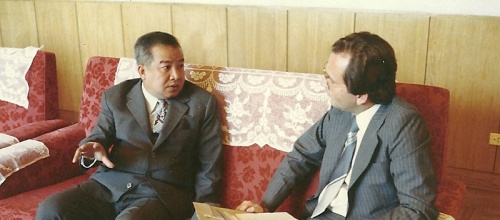|
January 1979 and June 1985. He was no doubt Cambodia's most influential, most charismatic, and most erratic leader. The on again, off again King. The late Norodom Sihanouk: wily politician, honored guest of the Chinese and North Koreans, musician, movie maker, and monarch. I met Samdech Sihanouk - first in Beijing in 1979, then five years later in North Korea. In both encounters the strength of his eccentric, magnetic personality was amply displayed.
On October 15, 2012, the Chinese news agency Xinhua reported the death of the former King of Cambodia Norodom Sihanouk. He died in Beijing less than a month shy of his 90th birthday. As a leader in Asia, he was a giant from a small country. I first encountered Sihanouk as a student in 1969. A paper I wrote among my Asian studies focused on Sihanouk's relationship with China. I examined Sihanouk's remarkable international balancing act in the 1960's as he pitted France, the United States, Thailand, Vietnam, and China against each other in a great balancing act to protect his fragile nation.
My first meeting with Sihanouk came ten years later in Beijing.
The Great Hall of the People was the setting for Norodom Sihanouk's reentry to the media spotlight. As Vietnamese troops closed in on Phnom Penh on January 5th, 1979 and the Pol Pot government and his Khmer Rouge fled westward, the Chinese sent in a plane to pull out their diplomats and rescue the Prince. Sihanouk and immediate members of his family, including his stunning wife Monique had been kept under house arrest for nearly three years by the Khmer Rouge in the crumbling Royal Palace in the largely deserted Cambodia capital.
In Beijing to mark normalization of diplomatic relations between the United States and China, I was summoned to the Great Hall with dozens of other journalists to meet the Prince. Sihanouk staged what was the longest news conference I had ever witnessed. Irrepressable, he seemed to want to make up for lost time; for years when his voice had been silenced.
He looked out at the assembled media looking for familiar faces.
James Pringle of Reuters raised his hand to ask a question. "Art Buchwald," the irrepressable Prince shouted, "I know you, I used to read your column all the time."
"No, your excellency" replied the bespectacled Pringle who did bear a slight resemblance to Buchwald, "I'm with Reuters news."
It was a mistake that Sihanouk would not repeat. Later Pringle and his Cambodian wife would develop a close relationship with the Royal family.
Next, Sihanouk singled out the Voice of America correspondent, Wayne Corey. The Prince had a short wave radio as one of his only diversions during his palace house arrest. He was devoted follower of the the VOA and the BBC World Service.
Five years later, I travelled to Pyongyang and met Sihanouk again. This time Cambodia's long time leader was housed in a palatial estate as the guest of North Korean leader Kim Il Sung. Again the Prince sought contact with the outside world. Railing against the Vietnamese occupiers of his country and yet embarrassed by the murderous Khmer Rouge with whom he and the Chinese had alligned themselves with... he sought a return to Phnom Penh.
That day finally came on November 14th, 1991 when Sihanouk flew into Phnom Penh after thirteen years in exile, to regain the throne as King the following year.
READ MORE OF MY MEETINGS WITH SIHANOUK in my book THE LAST HELICOPTER: Two Lives in Indochina (2020) |

